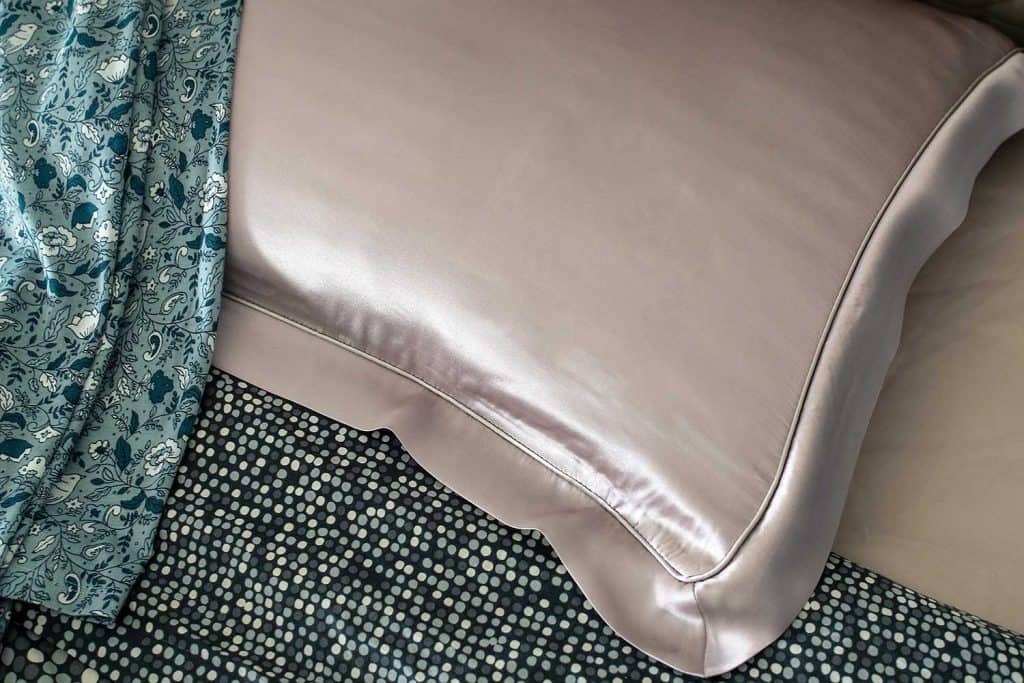When it comes to looking for a new pillowcase, silk and satin can be very appealing choices. And with good reason. Silk and satin are much better for your hair, skin, and comfort than materials like cotton. But what is the difference between silk and satin, and which is better? We have done all the research and have the answers for you!
Silk and satin are both soft to the touch, breathable, and less absorbent than other materials. Silk is a natural and hypoallergenic fiber but it is also more expensive than satin. Satin is a weave and can contain different fibers; it is not as breathable or soft as silk. However, it is easier to clean and still shares many of the benefits of silk without the hefty price tag.
It seems simple enough at first but there are many things to consider when choosing the right pillowcase. In order to better understand which type of material is best for your pillowcase, keep reading. We will also discuss the advantages and disadvantages of each material and how to maintain and take care of your silk or satin pillowcase.

Which Is Better: Silk Or Satin?
We sometimes add affiliate links and content that was curated and created by our team with the help of advanced ai tools to help showcase the best design styles.

As mentioned above, silk and satin are fairly similar materials with only a few key differences. Both materials provide a smooth and gentle surface that does not absorb moisture or dirt as easily as cotton. Both materials also reduce the friction between your head and pillow while sleeping. This means that both silk and satin pillowcases are way better for your hair and skin than cotton.
In order to help decide which material is better for you, let's breakdown what each material is, what its pros and cons are, and how to properly maintain the quality of your pillowcase after buying it!
Silk Pillowcases
As mentioned above, silk is a natural fiber attained from the cocoons and webs of certain bugs. In commercial silk production, the cocoon of silkworms is often used to produce silk. Silk is much harder to produce since a single thread of silk requires thousands of silkworm cocoons. This makes silk very expensive compared to other materials like satin and cotton.
Check out this silk pillowcase on Amazon.
Advantages Of Silk Pillowcases
Silk is regarded as one of the softest and luxurious materials. Because of this, silk is a very appealing material for a pillowcase. True silk is also a completely natural fiber which some people heavily prefer. While both satin and silk are breathable and great for your skin and hair, silk is generally more breathable.
Silk is also hypoallergenic which means it does not attract dust mites or other skin irritants. It is also a natural repellent to fungus. This means silk could be better for someone who suffers from skin problems! Silk also naturally regulates temperatures. This means silk will retain heat in the winters and provide a cooling effect in the summers.
Disadvantages Of Silk Pillowcases
As mentioned above, silk is natural and requires a lot of cocoons and effort to produce. Therefore, silk is usually 2-3 times more expensive than satin. Silk also requires more careful upkeep in terms of washing and drying, which can make it an inconvenient choice for a pillowcase.
Will Silk Shrink When Washed And Dried?
Silk is a natural fiber, so it can shrink when exposed to high heat. There is a possibility that silk will shrink and become damaged in the washer and dryer. Silk's shine and color can fade with improper washing techniques. You should hand wash and air dry silk. If you must put silk in the washing machine, you should use a delicate cycle with cold water and wash it with similar colors.
How Often Should You Wash Silk Pillowcases?
It is important for your skin and health to keep your pillowcase clean. While silk absorbs oils and dirt much less than other materials, it is recommended that you wash your silk pillowcases as much as you would wash any pillowcase or bedding. If you get lazy some weeks, it is much less detrimental with a silk pillowcase than with a cotton one.
Hand washing silk is the preferred method. It is easy to damage silk when using harsh detergents, heat, and strong washing machine cycles. Since silk can bleed quite easily, it is important to use cool or cold water.
Thankfully, silk does not hold dirt or oils well, so handwashing it is quite simple. All you need to do is fill a basin with cold water and then add a gentle detergent or shampoo. Give it a stir and let it soak for a few minutes. Make sure you air dry your silk pillowcase by laying it flat to reduce wrinkles.
Can You Sleep With Wet Hair On A Silk Pillowcase?
Sleeping on a silk pillowcase with wet hair should not damage your silk pillowcase. In fact, sleeping on a silk pillowcase with your wet hair can reduce the amount of frizz and natural moisture that is sucked out of your hair. However, since silk does not absorb moisture as well as cotton does, your hair might dry slower and your pillowcase might remain wet for longer than a cotton one would.
Satin Pillowcases
Satin is not a raw fiber in itself, but it is actually a complex style of weave that can include many different kinds of fibers from cotton, to polyester, to silk. While satin is not a raw material, the style of weave required to make it leaves the finished product feeling and looking much like silk, regardless of the specific kind of fiber used.
Check out these satin pillowcases on Amazon.
Advantages Of Satin Pillowcases
Like silk, satin is soft, breathable, attracts less dirt and oils, and sucks up less moisture. Since satin is not a natural material like silk, it is usually about a third or a half of the price. Depending on the type of fibers used in the satin of your pillowcase, it can be easier to clean than silk.
If the satin is made with durable fibers like polyester, you can usually throw it in the washing machine rather than handwashing it. You should use cold water and a delicate cycle when machine washing satin.
Disadvantages Of Satin Pillowcases
Satin is synthetic and you often have to be more careful to figure out what fibers are in the satin item you are buying. If satin is made up of too much cotton, it can greatly reduce the benefits for your hair and skin. Satin also has less of a shine than silk. It is less breathable and it is not hypoallergenic, which means it won't be as good for your hair and skin as silk.
How Often Should You Wash Satin Pillowcases?
Similar to silk, you should wash your satin pillowcase as often as you would wash any pillowcase. It generally stays cleaner longer than cotton due to its low dirt/oil absorption. Thankfully, unlike silk, you can usually wash satin pillowcases in the washing machine.
Does Satin Shrink In The Wash?
It depends on what fibers are in your satin, but washing satin with hot water will usually result in your pillowcase shrinking by as much as 10-20% of its normal size. You can avoid shrinking your satin pillowcase by washing it in cold water and on a gentle cycle. If you follow the washing instructions on your pillowcase, you should be able to keep your pillowcase from shrinking in the wash.
Can You Put Satin Pillowcases In The Dryer?
You should not put your satin pillowcase in the dryer. Even on a low-heat gentle cycle, you can damage your satin pillowcase in the dryer. Much like silk, the best method for drying your satin pillowcase is just to air dry it flat to prevent wrinkling.
Happy Sleeping!
Whether you decide to invest in a satin or silk pillowcase, we hope this article was helpful in answering all your questions. We wish you a happy slumber no matter what kind of pillowcase you have.
To read about the different types of materials used when selecting a comforter check out the 16 Different Types Of Comforters!
To learn more about the best carpet for the bedroom, check out The Best Type Of Carpet For The Bedroom.


